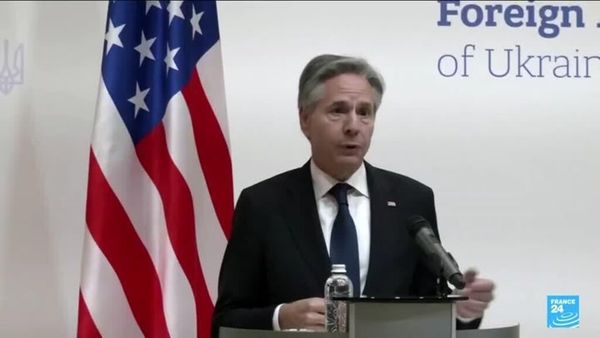
Up to 450 million citizens in the EU’s 27 member states will go to the polls between 6 and 9 June to elect more than 700 members of the European parliament, the world’s only directly elected transnational assembly.
The European parliament elections – more commonly called the European elections – take place every five years and, since the parliament plays an essential role in elaborating EU law, help shape the political direction of the bloc.
This year’s ballot, the first since Brexit, is being closely watched because opinion polls forecast significant gains for far-right and anti-establishment parties, which would have far-reaching consequences for the EU’s policy agenda.
Some observers believe that, despite the predicted surge of far-right “anti-European” parties, little may change in practice. Others say these elections could ultimately prove a defining moment for the bloc.
What does the parliament do?
Along with the council, which represents member states’ national governments, and the commission, the executive branch that proposes and implements EU law and runs the bloc day-to-day, the parliament is one of the union’s three core institutions.
Via the “co-decision procedure”, the parliament shares legislative power with the council, shaping and eventually, if they agree with them, approving new regulations and directives proposed by the commission.
The parliament represents the interests of EU citizens at European level, adopting laws that affect countries, companies and individuals in areas as diverse as migration, the rule of law, social policy, environment, security, consumer rights and the economy.
It also helps define the EU’s financial priorities, approving the EU’s multi-annual budget and scrutinising how the money is spent, and shapes the bloc’s executive, electing the commission president and approving the College of Commissioners.
How does it work?
MEPs are elected as members of national parties but, once they are in parliament, they generally join like-minded transnational political groups. There are seven such groups, with most national parties affiliated to one of them.
A group must have at least 23 members who between them must represent at least a quarter of the EU’s member states. The two largest groups are the centre-right European People’s party (EPP) and the centre-left Socialists and Democrats (S&D).
Parliament works in 20 specialised committees of between 25 and 80-plus MEPs, dealing with areas such as transport or defence. The membership and chairship of each should reflect the political makeup of the parliament as a whole.
How are elections organised?
Member states are free to organise elections as they wish, as long as they take place during the same four-day period and the number of MEPs elected from each national party is proportional to the number of votes it receives.
EU citizens who are resident in another member country can vote and stand for election there as long as they are registered. Many EU citizens living in non-member countries, including the UK, can also vote.
The next parliament will have 720 MEPs, 15 more than in 2019. The number from each member state is agreed beforehand and is based on the principle that MEPs from larger countries represent more people than MEPs from smaller countries.
The minimum number of MEPs from any country is six and the maximum is 96. In the next parliament, the three largest cohorts will be Germany with 96 MEPs, France (81) and Italy (76); the smallest will be Cyprus, Luxembourg and Malta, each with six.
When will we know the results?
No results will be announced until the evening of 9 June, so countries that vote earlier do not influence outcomes elsewhere. A partial estimation will be published at about 6.15pm CET and a more or less reliable picture should be available by 11pm.
What are the polls forecasting?
Some estimates suggest that radical-right parties are on course to finish first in nine countries, including Austria, France, the Netherlands and Belgium, and second or third in another nine, including Spain, Portugal, Sweden and possibly Germany.
Polls predict the far-right Identity and Democracy (ID) group, which at present includes France’s National Rally (RN), Austria’s FPÖ and Italy’s Lega, will advance from 59 to about 67 MEPs. Germany’s AfD – recently expelled – is on track for 17.
The nation-first European Conservatives and Reformists (ECR), including Poland’s Law & Justice (PiS), Giorgia Meloni’s Brothers of Italy, the Finns party, Spain’s Vox and the Sweden Democrats, is on course for maybe 75 seats.
However, the centre-right EPP is predicted to remain the largest group, with about 175 seats, more or less unchanged, and the centre-left S&D to again finish second, perhaps losing a few MEPs for a total of about 145.
The heaviest losses are forecast to be for the centrist Renew group, which includes Emmanuel Macron’s Renaissance, down from 102 seats to around 80 – possibly fewer than ID – and the Greens, who are forecast to lose up to a third of their seats.
What would that result mean in practice?
It’s very hard to say: much will depend on MEPs who are currently “non-inscrit” (non-attached), meaning they are not members of any transnational group – especially those from Viktor Orbán’s Fidesz party – and on a likely major reshuffle of the rightwing groups after the elections.
In theory, the EPP, S&D and Renew groups should retain a majority in the parliament, with neither a rightwing coalition of EPP, ID and ECR or a “euro-critical” coalition of ID, ECR, the Left and non-attached MEPs able to muster enough votes to pass bills.
RN leader Marine Le Pen has floated plans for a far-right “supergroup” amounting to a merger of ECR and ID, the two national-conservative and far-right groups, which might be able to slow or block commission proposals, jeopardising key projects such as the green transition and support for Ukraine.
However, Europe’s hard-right parties have failed to work together in the past and while they agree on some issues – such as migration and rolling back environmental legislation – are deeply divided on others, particularly on Russia and backing for Kyiv.
ID members such as RN are generally seen as more pro-Kremlin, while the prevailing view in ECR is exemplified by Poland’s PiS, which views a Ukrainian victory as essential to the future security of Europe.
National political ambitions also foster factional rivalries: Le Pen, who has led a determined effort to normalise her party, was instrumental in AfD’s expulsion from ID, suggesting the German party had become too toxic to be a suitable ally.
If, as expected, Orbán, whose party left the EPP in 2021 and is now non-aligned, decides his projected 14 MEPs should join ECR, a wholesale reorganisation of the parliament’s right wing is likely to ensue, perhaps featuring an entirely new group.
All that could have a profound impact on the shape of the new commission, with the executive’s outgoing centre-right president, Ursula von der Leyen, actively courting the backing of Meloni and the ECR, but centrist and socialist groups warning that any far right support would cost her their support for a second five-year term.







